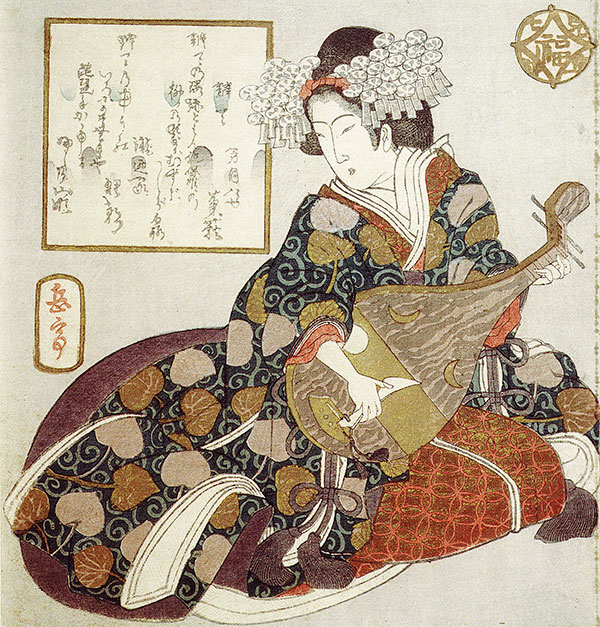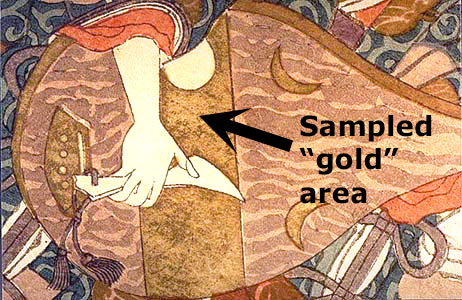

Were gold and silver applied to ukiyo-e prints?Certain mineral pigments were difficult to use in printing, as their grain size tended to be too large and angular, causing the grains to embed in the blocks and limit the options for controlling nuanced printing effects. Other mineral pigment mixtures, whoever, could be used to mimic precious metals. These colorants, discussed below, were applied in such a manner as to adhere to the paper surface with less absorption into the paper compared to organic pigments and dyes. Before the year 2000, many researchers assumed that 18th and 19th century ukiyo-e printmakers typically incorporated gold, silver, or copper in their designs. In the absence of scientific analysis, the lustrous appearance of metallic powders on ukiyo-e prints would seem to support this idea. The use of precious metals for privately commissioned, luxurious surimono (privately issued print) and limited-edition deluxe prints was also thought to be consistent with this conclusion. In addition, researchers have associated the metallics on ukiyo-e prints with the gold and silver leaf or powders applied to painted screens, albums, and illustrated hand scrolls, or with the gold and silver powders used in lacquerware.
Scientific analysis (see Shimoyama reference below) confirms that there were indeed some extremely rare print editions or experiments involving gold or silver on eighteenth and nineteenth-century Japanese prints. The famous series from 1765-66 by Suzuki Harunobu, titled Zashiki hakkei (A series of eight parlor views: 坐敷八景), included at least one design (Daisu no yau, Night rain on daisu: 台子の夜雨) with gold and silver. This applied only to the rare first edition of this series, which was an extraordinary commission from a Tokugawa retainer named Ôkubo Jinshirô (born Ôkubo Tadanobu, 1722-77), the founder of the influential Kyosen Renchû arts society and poetry club. Kyosen (Ôkubo's literary name; he also went by Jôsei Sanjin, "Recluse from west of the castle") is largely credited with funding Harunobu's earliest nishiki-e (full color "brocade pictures": 錦絵). His seal (reading "Kyosen": 巨川) appears on first-edition impressions, some of which he distributed privately in sets presented within an expensive paulownia boxes. In most instances the use of precious metallic pigments would have been prohibitively expensive for the commoner or merchant class (chônin or "persons of the town") to support on a wide scale. In addition, various sumptuary edicts during the Edo period proscribed the use of gold and silver by the townspeople as ostentatious and inappropriate to their class. As the chônin began to amass wealth and live in a manner previously reserved only for the samurai estate, the bakafu (the Shogun's government) issued sumptuary laws to reinforce the distinctions between the classes, to encourage frugality, and to maintain a Neo-Confucian system of moral conduct (see Sumptuary Edicts). Many regulations proscribed the consumption of goods and services and placed limits on luxurious entertainment, identifying what was appropriate for members of each social level and closely correlating consumption with social status. Publishers and printmakers would have been cautious in risking the government's punitive response to displays of excessive luxury among the chônin, as such penalties were on occasion quite severe.
I have published, along with two co-authors (see the first reference below for substantially more detailed information on this topic), an electron transmission analysis of metallic pigments on three 19th-century Japanese prints spanning about six decades. The earliest pigment samples were taken from an original surimono by the Edo artist Yanagawa Shigenobu II published in 1834 (see Shigenobu II for another impression of the design). The next samples were next taken from an original deluxe-style print in chûban-format by the Osaka artist Enjaku (see below and also Enjaku for the actual deluxe print used in the analysis) published in 1858. [Note that this Enjaku print was especially useful for comparisons because it contained examples of all three types of metallic pigments.] The final samples were obtained from a recarved c. 1896 copy of a surimono by Gakutei published originally in the late 1820s — early 1830s (see at the top of this page the Gakutei print as well as the detail of the gold-color sample area shown immediately above).
All the metallic flakes found in the "gold-color," "silver-color," and "copper-color" pigments in all the samples from the three prints were analyzed by EDX (Energy Dispersive X-ray Spectroscopy). Our analysis yielded consistent results from all the metallic pigments, none of which included any gold or silver. Instead, after excluding insignificant trace elements present either as impurities from the metal ores or as by-products of metallurgical processes, we determined that all the metallic mixtures were composed primarily of three types of brass particles: copper-rich brass, near equi-atomic copper-zinc brass, and zinc-rich brass. To create the desired metallic color, printmakers used predominantly copper-rich brass for "gold," zinc-rich brass for "silver." In addition, either pure or nearly pure copper was used for the copper-color pigments. This scientific evidence argues for a more cautious approach to describing the metallic powders applied to the great majority of ukiyo-e prints. While it might be disappointing to relinquish the assumption that metallic pigments on deluxe and surimono prints were gold or silver, the scientific evidence suggests otherwise. Perhaps "gold-color brass" and "silver-color brass" will serve well enough as appropriate terms to distinguish the copper-rich and zinc-rich powders, while "copper" remains an accurate term for the nearly pure copper found on ukiyo-e prints. Only in those extremely rare cases where it can be demonstrated that actual gold and silver have been applied to prints should we continue to use the terms "gold" or "silver." Note: A related scientific analysis also found copper-rich brass for gold-color pigments; however, tin was identified for the silver-color pigments. It is possible that both zinc-rich brass and tin were options available to ukiyo-e printmakers. See the Duncan reference below). ©2020 by John Fiorillo BIBLIOGRAPHY
Return to FAQ |
Viewing Japanese Prints |


